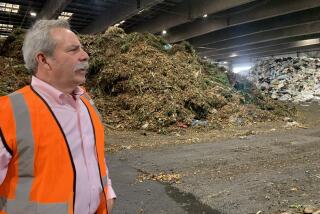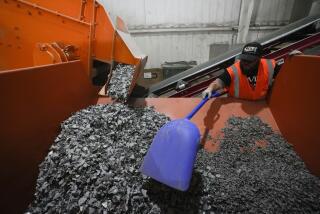Used Hardware Makes Its Move : Secondhand Computer Market Has Upgraded Into Big Business
- Share via
ANAHEIM — In a scrap yard built on the site of an old racquetball club here, the computers come to die.
Truckloads of aged PCs, printers and mainframe equipment pile up in the parking lot of Silicon Salvage Inc., waiting to be torn apart by crews wielding electric screwdrivers and power saws. Disk drives as big as toasters, cooling fans in black cases, green plastic circuit boards, all are piled up for resale or to be melted down for their gold and silver plating.
Although Silicon Salvage owner Chuck Hulse describes his operation as a junkyard, it’s more of an electronic butcher shop; most of the machines arrive in good working order. But they are yesterday’s models, slower PCs that can’t run the latest software or refrigerator-sized mainframes that cost too much to maintain.
Recycling, reselling or rebuilding these hulks keeps scores of small Orange County companies busy, along with several large firms, such as upgrade specialist Kingston Technology Corp. in Fountain Valley and repair giant Cerplex Group in Anaheim. That’s in addition to a cottage industry of consultants who help companies decide how much processing power they need.
As ever faster and more powerful computer programs are introduced, requiring more speed and memory, businesses that tear apart or resell displaced equipment are booming. Some electronics auctions feature PCs sold from excess inventories that have never been used.
“I lost track of how many roomfuls of computers I’ve hauled off,” said Hulse, who keeps 14 employees and three trucks busy unbolting and unplugging PCs from offices across Southern California.
Buying in bulk from bigger organizations, such as Lockheed Corp., Southern California Gas Co. and UCLA, Hulse said he often gets the oldest PCs for as little as $10 apiece if he takes them away.
With the parts inside computers often selling for more than the machines are worth intact, Hulse said, the development of the salvage business was “inevitable.”
“Everybody’s gotten pretty conscious about what’s in the computers,” Hulse said. “It used to be where I’d be going through people’s trash, but now I wouldn’t find much.”
Hulse’s work occurs near the bottom of a computer food chain that begins when businesses and home users decide their machines can’t handle newer versions of software programs or are not compatible with newly installed PCs on their office networks.
At that point, says Newport Beach consultant Gary Koch, a business faces a bewildering array of options: whether to upgrade some or all of its older machines; whether to buy more powerful equipment, either new or used, and choosing how much to spend.
“A lot of it is just the learning curve people have with their software,” Koch says. “It’s not that their computers are too slow, it’s that they’re better at using them and suddenly (computer) speed is an issue.”
The market for used computer equipment and upgraded or spare parts has grown along with the overall PC industry. Executives at several computer-exchange companies estimate that nearly $2 billion worth of used PCs, monitors, printers and other devices were sold in the U.S. secondhand market last year. About $11.5 billion was spent on the repair and upgrade of older PCs, workstations and mainframe computers last year, estimates Don Blumberg, an industry consultant in Fort Washington, Pa.
Michael S. Jordan, president of United Computer Exchange Corp. in Atlanta, said his company arranges 5,000 sales a month, many involving more than one machine. The buyers are small-business owners, parents looking for an inexpensive machine for young children and college students, he said.
“If you have an 8- or a 9-year-old, you don’t want to spend $2,000 on a computer for them, you want to get something to introduce them and get used to the idea of a computer,” Jordan said. “You’ll be less worried about the hassle of, ‘Will it work with what I’ve got?’ ”
The sellers, meanwhile, are often larger companies and universities. Home users tend to sell to friends or relatives, or stash old machines in the attic, Jordan said.
The Gartner Group, a consulting firm in Stamford, Conn., estimates that companies will retire 50 million to 70 million PCs between 1992 and 1996. And Chris Goodhue, author of the company’s estimate, said that even that range is at best an educated guess.
“We did some spreadsheets aimed at calculating PC retirement, but the problem we ran into was: How do you define retirement?” Goodhue said. “Is it just that a machine gets retired forever, or does it also have to be out the door of the firm?”
Fred Anson, for one, can’t wait to boot a few machines out of his company’s door. Information systems manager of the Irvine pharmaceutical maker Cocensys Inc., Anson says he has trouble getting the company’s nine Apple computers to work with 104 other machines running on the IBM-compatible operating system.
“I want them out of the building, period. They’re too hard to integrate,” he says.
The Macintoshes, which cost $5,500 when new two years ago, have been depreciated to a third of that on the company’s books, he said. But the machines would sell for only about $1,000 on the street today, and upgrading them to work with the other PCs would cost about $1,000 each. But even an upgrade wouldn’t make them fully compatible.
Anson thinks the company’s money would be better spent on newer machines. Cocensys originally bought the Macs to run chemical diagraming software, but such programs are now available for DOS. Anson hopes to auction the Macs to employees as soon as the company has enough money to buy replacements.
One easy option for companies ready for new machines is to shift older computers to less demanding applications. But that is often difficult, said Drew Erdman, a manager for computer procurement and installation at Taco Bell Corp., because machines must still communicate with each other.
Taco Bell and many other large companies donate some used machines to schools, charities and other nonprofit groups.
Yet most older machines retain some commercial value, and are sold to brokers or employees or traded to the original equipment manufacturers, often for credit on newer machines.
Locally, the middlemen who add value to used machines range from small parts operators like Oscar de la Garza, whose four-employee business, Dela Computer Marketing in San Clemente, had revenue of about $800,000 last year, to Aurora Electronics Inc., an Irvine firm formed two years ago that did $130 million worth of business in fiscal 1994. Both sell parts and components, and work with repair and service companies.
“I try to stay in the mid-range (computer) market, since the PC parts have gotten to be so cheap,” De la Garza said. “You could say we’re supplying almost the same parts that IBM can get you. . . . We try to have a faster turnaround, though.”
Bob Allison, Aurora’s chief operating officer, said his company, though far bigger, was founded with a similar goal of helping users extend the life of their machines.
“When you go to tell a customer how they should cope with older computers,” he said, “there’s really no right answer, except there are a lot of ways they can do it. That’s what makes the business work.”
Bill Klein, founder and chief executive of the Cerplex Group Inc. in Anaheim, said that the used computer market resembles the auto industry, with all shades of support services, parts and salvage companies.
From its founding in 1990, Cerplex has grown to about 1,500 worldwide employees--450 in Orange County--and it estimates nearly $130 million in revenue this fiscal year, according to Klein. The company has benefited from growing demand for computer-repair services from companies that don’t want to part with older systems.
“We’re doing a lot of the same things you’ll see auto-parts companies doing,” he said. “It’s taking old hardware back from the field that’s either broken or out of service, and tearing it apart for parts or reconditioning it as spares.”
Computers are easier to upgrade than cars, of course. New monitors, more powerful disk drives and enhanced circuit boards are staples of the upgrade market. Privately held Kingston Technology, which specializes in such aftermarket PC components, expects revenues of $800 million this year.
Peggy Kelly, a Kingston spokeswoman, said that many of its customers are companies that no longer have employees who don’t already own computers and can make use of hand-me-down PCs.
“It used to be that, rather than spend the money on upgrading older machines, businesses could just pass them around to other departments,” Kelly said. “Now, everybody has one (a PC) on their desk.”
Accountants frown on throwing away computers that are less than three years old and not fully depreciated, said Ron Seide, Kingston’s marketing director.
“The effective life of a system can be a long time, well past its depreciation--maybe it’s 10 years, or until its power supply burns out,” Seide said.
However, some managers shy away from upgrading more than a few computers at once. While spending $200 to $300 for an upgraded microprocessor chip might look attractive, he said, it won’t be the only expense.
“It might look good if you have a 286 machine and somebody says they can make it into a 386,” said Bob Smith, a systems support analyst at Century 21 in Irvine. “But then you have to have more hard drive space, a bigger monitor, more memory. By the time you put all the pieces together, you haven’t saved much, and you’ve got a more complicated machine.”
A consultant’s rule of thumb had been that a business person could spend about $2,000 on a new PC setup that included a printer and software. But even that figure is declining--two years ago $2,000 would have bought a 386 desktop machine but today’s notebook computers with 486 chips, which are more than four times as powerful, now sell for close to half that amount.
Even PCs built around Intel’s advanced Pentium microprocessor chip, which was introduced just last year, have started to turn up at the auctions run by broker J. R. Rodeffer every few weeks at the Santa Ana warehouse of his company, BBC.
Rodeffer said he often buys machines from businesses that were “taken in” by advertising claims and aggressive marketing by resellers, sticking them with equipment they don’t need.
“A lot of people overbuy their computers. Most people could use a decent 386 or 486, but the industry hypes them on ‘new and improved!’ (machines),” Rodeffer said, referring to less-advanced Intel chip models.
Rodeffer said he also auctions unsold computers acquired directly from manufacturers that had surplus inventory, including AST Research Inc. in Irvine and PC market leader Compaq Computer Corp.
“They have to concentrate on the hot new sizzle,” Rodeffer said of the larger companies’ priorities. In contrast, the used and discontinued models he auctions often sell for half of their original retail price. “They don’t want to spend their salesmen’s time on stuff that they can sell through quieter channels.”
AST said it holds several auctions of machines it receives back from customers every year. In fact, the company planned to sell about 2,500 refurbished machines in Las Vegas this weekend as the Comdex industry trade show gets underway.
Dennis Cox, AST’s director of marketing for consumer products, said the company doesn’t see the used market as a threat to its sales because of the superior computing power of newer models.
Rodeffer said his company no longer buys machines based on Intel’s 286 processor, which was introduced about 10 years ago. Too slow to run today’s programs and with an average selling price of under $200, these vintage PCs aren’t worth the trouble, he said. The last batch of 286 machines he handled were sold to brokers in Russia last spring, he said.
At a BBC auction earlier this month, 150 people looked over lots ranging from used notebook computers to six-outlet electrical extension chords and boxes of software. Dallas-based auctioneer Bart Seagers gave the event the feel of a farm foreclosure sale, but the crowd was a discerning mix of students, technicians and small-business owners.
A flashy, used Apple Powerbook 145B sold for $725, for example, about half of its retail price a year ago and $125 less than its published trading value on Atlanta’s United Computer Exchange.
Matt Remfert, a networking consultant based in Santa Ana, came to look at Apple equipment and by the end of the day had spent $300 on word processing software and computer circuit cards to help display video images. The equipment, if new, would have cost about $900 at a retail store, he said.
“The prices have been getting high lately” as more users catch on to the secondary computer market, Remfert said. But he cautioned that some people were buying equipment they didn’t necessarily need.
“Just because you can get a low price on something doesn’t mean you’ll be able to use it,” he said. “I think it’s because everybody here has got the bidding bug.”
* HOW TO REBUILD old PC. D3
More to Read
Inside the business of entertainment
The Wide Shot brings you news, analysis and insights on everything from streaming wars to production — and what it all means for the future.
You may occasionally receive promotional content from the Los Angeles Times.










